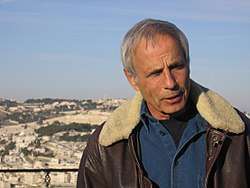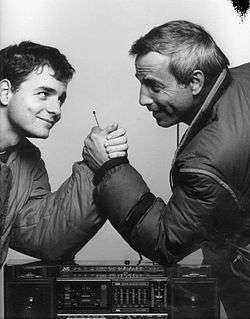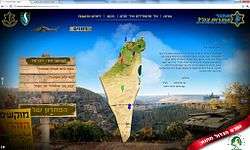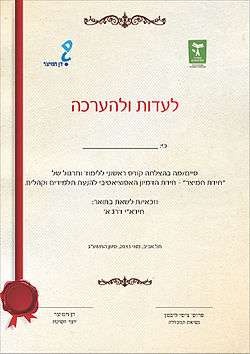Dan Chamizer


Dan Chamizer, born in Jerusalem, grew up in Ramat Gan and lives in Ein Hod, an artists village at the foot of the Carmel mountains in northern Israel. His father, Emmanuel Chamizer, was killed during Israel’s War of Independence in the ‘Battle of Nitzanim’.[1] His grandfather was the physician and sculptor Raphael Chamizer, and his son is the Israeli television producer Giora Chamizer .
Military service and columnist
During his military service, Chamizer was a helicopter pilot, and after discharge from the IDF he pursued his interest in flying, becoming a commercial pilot with Arkia Airlines and a pioneer in Israel's fledgling micro-aviation industry. In addition to his career as a pilot, Chamizer was a columnist for several Israeli periodicals, including Monitin, Koteret Rashit and Tsomet Ha’Sharon. He was also a regular contributor to mainstream newspapers such as Davar, Ha'aretz, Yedioth Ahronoth and Ma'ariv. Chamizer found his way also to broadcast media, and was a radio presenter on Galei Tsahal and a TV host in the Televizia Ha’Klalit. As part of his journalistic activities, he also co-produced hundreds of nation-wide treasure hunt games with Zeev Aner.
Education and instruction
Chamizer holds an MA in Social Sciences from Tel Aviv University (1978). His MA thesis, at the Department of Labor Studies, dealt with the impact of environmental and human factors on pilot error, and was considered groundbreaking for its examination, analysis and understanding of the processes (hitherto confidential) that take place in the cockpit. .[2]
 Chamizer abandoned helicopter blasted by Jordanians.
Chamizer abandoned helicopter blasted by Jordanians. Ultra-light plan landing in lake Kinneret.
Ultra-light plan landing in lake Kinneret. Chamizer as flight instructor on student firs landing.
Chamizer as flight instructor on student firs landing. Chamizer research work for Tel Aviv University 1978.
Chamizer research work for Tel Aviv University 1978.
Riddler

Chamizer rose to fame largely thanks to a daily spot on Razi Barkai and Shelly Yachimovich’s radio show, "Hakol Diburim" (1990-1997). The show was broadcast on the Reshet Bet radio channel, and Chamizer had a featured item called "Chidat Chamizer" (Chamizer’s riddle). In it, he showcased a unique type of riddling, based on imagination and associative thinking rather than general knowledge. The riddles proved challenging to solve, and those attempting them had to ‘enter the mind’ of Chamizer – identifying and decoding his personal associations – if they hoped to succeed.
The cumulative prize for solving the riddles increased every day and often amounted to substantial sums of money, thus attracting a large audience. In its seven years on air, the percentage share of listeners increased to 17% Cementing Chamizer’s position as one of the most innovative contributors in radio. After leaving "Hakol Diburim", Chamizer moved on to develop and produce various TV game shows, including "Otzar Hanegev", "Yemei Eden BaGalil", "Yovel La’Medina", "Treasures of One Hundred Years of Zionism", "Treasures of World Cup Football", "Treasures of Israel at 60".
He returned to radio in 2004 with a new game show called The "Chamizer Sentence", which to date still boasts the highest individual prize awarded in the history of Israeli radio game shows- NIS 240,000. In 2009, Chamizer produced the VOD Treasure for HOT TV, and in 2010 he produced The Treasure of the Century, celebrating 100 years of the Kibbutz Movement in Israel, followed by the New Israel Defense Force Quiz a year later, in 2011.
For decades Dan Chamizer has inspired Israelis to connect en-masse with opportunities for informal study via riddles, puzzles, games, nationwide treasure hunts and innovative educational projects. His surname – Chamizer – has become synonymous among Israelis with any riddle or intellectual challenge that requires wit, imagination and creativity to solve, and it has entered Hebrew slang as a verb, often conjugated playfully to describe the solving of sophisticated riddles. Dan Chamizer's surname has become synonymous among Israelis with any puzzle or intellectual challenge that requires wit, imagination and creativity to solve .
Chamizer in education

What began as a daily riddle slot on the radio, eventually led hundreds of thousands of Israelis towards computers, databases, archives and libraries, and saw them engaging in creative thinking, developing original research tools and devising new methodologies to solve the challenges set by Chamizer. Inspired by the response, he set out to explore the educational and training potential of being able to reach such a large and diverse audience.
Chamizer developed the "Teaching through Riddles" educational method, where imaginative-associative riddles – characterized by playful wit, wild leaps of imagination and outlandish word association – became part of the approved national teaching curriculum in Israeli schools. To date, over half a million students have taken an active part in projects based around Chamizer riddles.
Dan Chamizer sees his riddles as tools for encouraging inventive thinking. He explains the purpose of the method as follows: "The imaginative-associative riddle, like many of life’s problems, has endless solutions. Therefore, finding the correct approach to solving one, offers a perfect simulation for other life challenges that demand a creative input."[3]
The method lends full legitimacy to unconventional thinking and unmediated means, stimulating curiosity, creativity, enthusiasm and competitiveness. The coveted cash prize goes to the player who manages to "enter the riddler’s head," but much credit is also given for improvisation, initiative, creative thinking, teamwork, leadership, focus, openness, self-confidence and courage – and these are the qualities that truly matter. In his words: "My aim is to instill an alternative way of acquiring study skills and assimilating knowledge."
In 2010, Chamizer has built the "National Riddle Archive".[4] A dynamic online database of imaginative-associative riddles), in association with The Kibbutzim College of Education and The Teachers' Union in Israel. Designed to be used as a teaching resource, facilitating both formal and informal learning, the archive is aimed at professional educators and is linked to study topics outlined in the national curriculum.
Educational projects
Examples of projects using the ‘Chamizer education method’:
- A groundbreaking online project that allows every participating teacher in Israel to select and receive relevant associative riddles with which to engage their pupils (launched 2015).
- An annual national initiative that motivates school pupils in Israel to recognize – in a playful, unmediated way – the importance of lifestyle in fostering a healthy heart (Hebrew and Arabic).
- A unique, Haifa-based educational initiative, not only connecting pupils and parents to their own neighborhoods and communities, but also illuminating their shared past and introducing them to other educational establishments in their area (launched 2015, in Hebrew and Arabic)
- A two-year nationwide project intended to facilitate an understanding of the legacy of Israel’s former leaders among Israeli schoolchildren (launched 2013)[5]
- A national project aimed at promoting opportunities for greater exposure to the culture and heritage of Ethiopian Jewry among the wider school population in Israel.[6]
- A project examining, defining, and promoting the legacy of the Israeli Labour party, its philosophy and its leaders. (launched 2012, in association with Beit Berl Education College and the Knesset)
- An innovative makeover for the classic IDF (Israel Defense Force) quiz, designed to give every soldier the opportunity to demonstrate their knowledge of the force’s core values, its national heritage and its position on environmental issues (launched 2010)
- Monopoly-like interactive game, created for the Ministry of Education, emphasizing the importance of the Hebrew language and its correct usage (launched 2009).[7]
- An interactive game designed for the benefit of school children in Eilat, teaching them about the city’s heritage and history (launched 2013-15)[8]
- An interactive game designed to help Israeli high school pupils assimilate curriculum content in Sociology (launched 2013-15)[9]
- Nationwide educational game, in association with the Israeli Ministry of Education, connecting Israeli children with immigration centers around the country, and facilitating a better understanding of the importance of successfully integrating immigrant children into society (launched 2016)
Artist, writer and environmentalist
A long-standing environmental activist, Chamizer produced a series of games designed to promote environmental awareness amongst Israelis. Including "The row of suckers" and "A garbage state". These projects highlighted and often unwitting, harm done to the countryside by Israel’s own citizens and the challenge represented by the attitude of profit-seeking power brokers.
Chamizer is a resident of the artist village of Ein Hod.[10] He is active there as a conceptual plastic artist, and his environmental statues can be seen in gallery and museum exhibitions throughout Israel. Chamizer is also a published author and poet, and his Chidani series of titles for children are well known
Publications
Art works
 “I have no other country” – Artists’ Gallery, Ein Hod.
“I have no other country” – Artists’ Gallery, Ein Hod. Truth or Nothing by Dan Chamizer in Ein Hod.
Truth or Nothing by Dan Chamizer in Ein Hod. Happy Glasses of Itche Ein hod
Happy Glasses of Itche Ein hod “Oh, my country” – Janco Dada Museom, Ein Hod.
“Oh, my country” – Janco Dada Museom, Ein Hod. The riddle of Tel Aviv.
The riddle of Tel Aviv. The end of days mail boxes" Ein Hod.
The end of days mail boxes" Ein Hod.- “The Mediterranean sea” – Street Art, Haifa.
 “The state of the nation” Ein Hod 2001.
“The state of the nation” Ein Hod 2001. “Azulai the cop”– Street Art, Ein Hod.
“Azulai the cop”– Street Art, Ein Hod. Table Football Playbox, Street Art, Ein Hod.
Table Football Playbox, Street Art, Ein Hod.
Books
- Chamizer’s book of riddles: From the mechanized Italian to the Iraqi finger (Keter, 1992)
- Panta Rei: Casualties in Grandma’s trunk (Zmorah Bitan, 1998) – a biographical evocation of Chamizer’s father, Emmanuel.[11]
Children’s books:
- Chidani in the animal kingdom (Matar, 2009)
- Chidani meets friends[12] (Matar, 2010)
- Chidani protects the environment (Matar, 2011)
Poetry
External links
- List of publications by Chamizer, in the National Library catalogue
- Chamizer’s internet website – Chamizer.com
- Cheruti-Sober, Tali, The biggest mystery of all: how much money does Chamizer make from his riddles? in The Marker, 25 April 2012
- Zorea, Chen, The orthodox demolish Zionism: eye to eye with Dan Chamizer, nrg website, 17 October 2012
- Aharon Barnea Interview with Dan Chamizer in the radio programme "Those were the days" on the Knesset Channel, Youtube, 27 July 2016
- Cheruti-Sober, Tali, Our Airforce friends trod over our bodies, The Marker, 9 March 2017
References
- ↑ Emanuel Chamizer in Izcor Memorial site.
- ↑ Ein Hod: A Unique Village in Israel Archived 3 March 2016 at the Wayback Machine., Emunah
- ↑ Dan Chamizer explains imaginative riddle in education
- ↑ National Riddles Archive
- ↑ Israel Leaders Legacy 2015.
- ↑ Discovering "Et Yof Ya" - her beauti
- ↑ Hebrew Language Enhancement in the Educational System
- ↑ The History of Eilat
- ↑ Sociology students in Israel
- ↑ Dan Chamizer, in Ein Hod site.
- ↑ Panta-Rei -Casualties in Grandma’s trunk
- ↑ Booknet
- ↑ Close Formation - flying to combat
- ↑ Crash Landing 1997